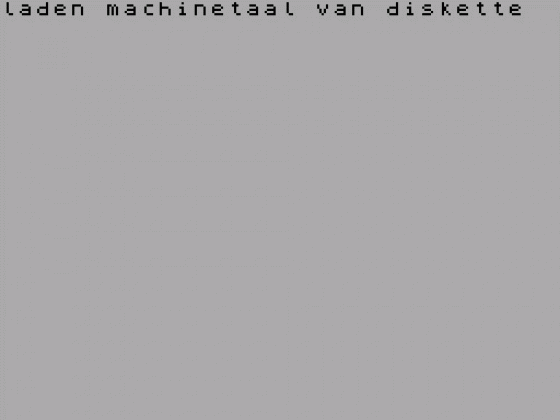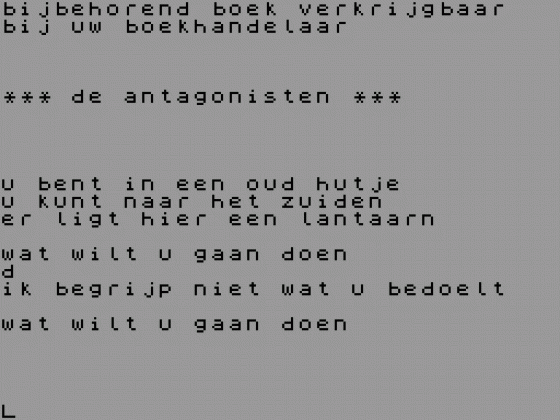
Crash
 1st August 1985
1st August 1985
Categories: Review: Software
Publisher: Addison-Wesley
Machine: Spectrum 48K/128K
Published in Crash #19
The Antagonists
The Antagonists, a Microworld Adventure from Addison-Wesley Publishing, follows Arendarvon Castle. Once again, you can buy the book and type in the program or buy both the book and program. Both games have a very similar format with an interesting and highly informative book supporting unimaginative and somewhat primitive software. It's difficult to do the game justice in this review with such lacklustre coding, so much of what I will say will necessarily pertain to the book which looks very much like any other that might be found lining the shelves of a bookshop.
Its content is also impressive and sets in motion a process I very much admire in that it encourages the player to seek out and use information from a dossier file which, taken as a whole, describes the strange world in which you find yourself.
The file you carry has some diary entries of one Albert Renshaw, more of whom later; a book on flowers by a learned profession; a publication from the James Arwell Society commemorating one of the greatest scientists who ever lived; and a guide to Insectoland, an insect Disneyworld built in the 23rd century.

Albert Renshaw's diary might just be as boring as anyone else's were it not for one thing - in a world dominated by insects and ruled by ants it was he who had the dubious distinction of being the last surviving member of planet Earth, a sort of Omega Man armed with fly spray. As every budding 20th century biologist knows, the insects, which are the largest single group of animals on Earth, have one serious limitation imposed upon them by the way in which they breathe - through pores and the tubes which lead from their tough outer skeletons - which prevents them from reaching any threatening size. So why doesn't our Renshaw chappie don a large pair of boots and simply walk all over this assail*ants*?
Well, the answer lies in the curious delight afforded any blue-blooded scientist by meddling in areas he knows next to nothing about. In this case, the 21st century had not only produced curious like chemical sociology and psychological physics but a wondrous growth hormone which certainly grew livestock and foodstuffs more quickly, but also had the disconcerting effect of spawning whopping great big creepy crawlies which had the wherewithall to try and flush *you* out of the bath.
All good science fiction turns humour into a satirical scalpel, and this book is no exception. Two funnies stick in the mind particularly. The first relates how, as insects got bigger, so did the movement concerned with insect warfare and the second how the prefaces to The Book of Flowers tells of the way iin which a Professor Rosebush's classification superceds that of the deceased Professor Lanuski's, even though Lanuski, the previous editor of the treatise, had expressly attacked Rosebush's classification in an earlier preface. Hence the prefaces relate how classifications only last as long as their proponents and, more generally, how science is full of pompous pedants.
Turning to the adventure itself, much of the early play is within fields and the caves beyond them. Throughout the adventure you must research and make reference to your dossier (which in reality is the glossy softback book) and this first part is no exception. In the fields are scattered various flowers and as you climb their stems you relate the on-screen information with that in the Book of Flowers. This however is no easy task as the program is deviously sketchy with one or two of its descriptions, but of course, some are instantly recognisable and you then refer to the guide with renewed confidence. The flowers are realistically, and usefully, divided into the niches of marine, fresh, swamp, wet and dry.
There's just a touch of sci-fi philosophy within the James Arwell Soc publication. It puts forward the hypothesis that the hallmark of true genius lies not in the complexity of a theory but in its simplicity and accessibility - and so it reckons Elvis Presley and Michael Jackson were the real geniuses when compared to the likes of Bach, Mozart and Beethoven. (An interesting theory on the rise of popularism and the decline of Radio 3). The publication also tells of the Lepries, who have a total lack of physical beauty but are friendy enough, and the Tennis, who are similar to elves but can change rapidly in mood to become dark and deceitful. Lepries enjoy a kind of blueberry soup which turns the leprie blue except for the hands which become a bright yellow hue.
The guide to Insectoland gives information and clues concerning the various giant ants, bees, flies, beetles and butterflies which inhabit the park. A creature you will soon be looking up in the guide is the glow-worm which emits light during its whole life-span, and we learn how the production of light decreases if the worm is deprived of honey.
The Antagonists is a fine book, but the poor quality of the software on the tape lets it down. It's a little amateurish to expect the player to type RUN after the first part of the program has loaded in! The appearance of the screen is very dull with the original black Spectrum print left on a glaring white background. If you loa the first part of this program you may find it better to then add 100 INK 6:PAPER 0:BORDER 0:CLS and then SAVE'ANTAG'LINE 1 which will allow an auto-RUN.
Although the book creates a good atmosphere, the location descriptions in the program are sparse and disappointing. Some locations have nothing on your present predicament but merely tell you what is in adjacent areas, which gives certain regions an anonymous feel. As with the first game, the vocabulary is very limiting and there doesn't appear to be any equivalent of EXAMINE. The game is not difficult but trying to correlate the cave system to its textbook equivalent may take some time.
The Antagonists is a noteworthy project but I feel more effort could have gone into the programming aspect which, after all, is what most software is all about!
Comments
Difficulty: Quite easy
Graphics: None
Presentation: Poor
Input Facility: Generally verb/noun, though needs a weapon specified for combat
Response: Very fast
General Rating: Detailed and interesting book, program locations poor


